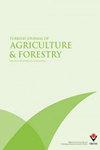Expression of the genes (CBF2, CBF4, NCED1, MYB14, PLD) during acclimation and de-acclimation in dormant buds of Chambourcin and 3309 C grapevine accessions
IF 3
2区 农林科学
Q1 AGRONOMY
引用次数: 0
Abstract
: Deacclimatization results in a loss of bud cold-hardiness whereas cold acclimation results in an increase in it. The regulation of the buds’ cold acclimation and deacclimation in woody plants are poorly understood. This study indicated that differential gene expression during acclimation and transition of the buds from acclimation to deacclimation in the light of dormancy and bud water content. One-year-old vine latent bus of cv. Chambourcin vines and 3309 C ( Vitis riparia x Vitis rupestris ) were used for the analyses. Five genes ( CBF2, CBF4, NCED1, MYB14 , and PLD ) were selected for quantitative real-time PCR. Quantitative real-time PCR was applied to measure gene expression of the dormancy related genes and GAPDH gene was used as a reference gene. CBF2, NCED1 , MYB14, and PLD were strongly upregulated by both with the two-temperature treatment (acclimation (5 °C) and deacclimation (15 °C)) and two different time applications (one and two week) while the expression of CBF4 was low after the applications. Among these four upregulated genes, NCED1 and PLD exhibited the highest level of expression (121.02 and 86.40, respectively) at cold hardy 3309 C during deacclimation (T2, 15 °C). However, for the 5 °C treatment, Chambourcin showed the highest level (32.61) of MYB14 gene expression during T2 application, while 3309 C buds had the highest NCED1 gene (94.83) expression level again during T2 application. According to the results, it is clearly highlighted that PLD and NCED1 gene expression level was highest at cold hardy 3309 C during dormancy and release of dormancy.CBF2、CBF4、NCED1、MYB14、PLD等基因在香槟酒和3309c葡萄休眠芽驯化和去驯化过程中的表达
脱环境导致芽抗寒性的丧失,而冷驯化导致芽抗寒性的增加。木本植物芽的冷驯化和脱驯化的调控机制尚不清楚。本研究表明,根据休眠和芽含水量的不同,芽在驯化和从驯化到脱驯化的过程中基因表达存在差异。一年生葡萄潜伏病菌。香槟酒和3309 C (riparia葡萄和rupestris葡萄)作为研究对象。选择5个基因(CBF2、CBF4、NCED1、MYB14和PLD)进行实时荧光定量PCR。采用实时荧光定量PCR法检测休眠相关基因的表达情况,以GAPDH基因为内参基因。CBF2、NCED1、MYB14和PLD在两种温度处理(驯化(5℃)和脱驯化(15℃))和两种不同时间处理(1周和2周)下均显著上调,而CBF4在处理后表达较低。在这4个上调基因中,NCED1和PLD在3309℃脱驯化(T2, 15℃)时的表达量最高,分别为121.02和86.40。而在5℃处理下,Chambourcin在T2处理期间MYB14基因表达量最高(32.61),而3309 C芽在T2处理期间NCED1基因表达量最高(94.83)。结果表明,PLD和NCED1基因在3309℃寒性休眠和解除休眠时表达量最高。
本文章由计算机程序翻译,如有差异,请以英文原文为准。
求助全文
约1分钟内获得全文
求助全文
来源期刊
CiteScore
4.20
自引率
6.90%
发文量
42
审稿时长
12 months
期刊介绍:
The Turkish Journal of Agriculture and Forestry is published electronically 6 times a year by the Scientific and Technological Research Council of Turkey (TÜBİTAK).
It publishes, in English, full-length original research papers and solicited review articles on advances in agronomy, horticulture, plant breeding, plant protection, plant molecular biology and biotechnology, soil science and plant nutrition, bionergy and energy crops, irrigation, agricultural technologies, plant-based food science and technology, forestry, and forest industry products.

 求助内容:
求助内容: 应助结果提醒方式:
应助结果提醒方式:


